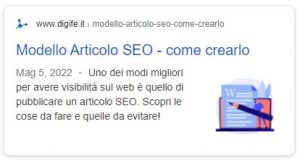
One of the best ways to get visibility on the web is to publish a SEO article, or, better said, an SEO optimized article. For it to be effective, however, it is necessary to know which characteristics it must have and which ones are to be avoided.
In fact, if on the one hand a well-written article becomes a spring that pushes your site up, a poor article will have the opposite effect, "hiding" your web page from the eyes of potential customers.
In these lines we will provide you with basic guidelines and a template of SEO article to follow to ensure your articles are optimized for search engines.
The rules for optimizing an SEO article
Before starting it seems appropriate to provide some general information to better understand how search engines work. When a user searches on Google, for example, the search engine uses a series of rules to determine which pages to show in the results and in what order.
To ensure that your article appears at the top of the search results, and is therefore visited, it is necessary to carry out the correct optimization of theSEO article. In this sense the most important elements are:
- the key word;
- the title of the article;
- the metadescription;
- the titles of the chapters;
- the index of contents.
Keyword
All theSEO article it must necessarily start from the study of a keyword that is inherent with the content of the text. Analyzing which keyword to use for your article is arguably the most important aspect of all SEO work.
Simplifying, we can say that the keyword must be the one most searched for by users based on the topic covered. In this article, for example, the keyword must be linked to the correct spelling of a SEO article.

Title
The title ofSEO article it's not just the first thing users see when they go to the page it is placed on. The title is the first thing that appears when an individual searches the web.
This element (which is also called title, from English) is therefore of fundamental importance for two reasons. First of all, on a more technical level, the title it must contain the keyword that exemplifies the topic dealt with within it. This will allow the text to appear when that keyword is typed into the browser.
Second, a title captivating will have a better chance of attracting the attention of a potential reader interested in learning more about the topic.
For example, the owner of a business that has recently opened an e-commerce could be interested in SEO to increase the visibility of the new platform. That is why the article you are reading is called SEO Article Template - how to create it.

Metadescription
If you are familiar with internet browsing you will know that when you search the title is not the only thing that appears in the results. Immediately below, in fact, the title is accompanied by a brief description that deepens the content of the page. This text is called metadescription.
Similarly to the title, the metadescription it must contain the reference keyword and, at the same time, capture the reader's attention. There metadesciption effective is in fact the one that manages to arouse the curiosity of users.

Titles H1, H2, H3
If the two previous points concerned aspects "external" to the article itself (especially the metadescription), L'SEO article it must also be optimized in its content, starting with chapter titles.
The most important title is undoubtedly the H1, the main title (not to be confused with the title, the title of the article). It must contain the keyword but must not be a copy of the title. In practical terms the H1 must recall the concepts expressed by title is metadescription.
The optimization of the titles of the following chapters, i.e. H2, H3, etc., is also important from an SEO perspective. Each of them must contain a sub-theme of the general topic. Their usefulness consists, on the one hand, in indicating to the user the micro arguments that are expressed in that section. From a search engine point of view, however, these titles facilitate the analysis work of browsers, which are able to understand the topic of the article more precisely.
Taking this article again as an example, the H2 title of this chapter is "Titles H1, H2, H3". This choice was made to make you understand that you are reading these lines that in this section we would have dealt with the titles of the individual paragraphs. At the same time, the crawler of a search engine, reading the title, understands that the topic is linked to the more general one ofSEO article and it is also able to extrapolate other relevant keywords, improving the visibility of the article.
Content index
In very complex articles, with a large number of chapters and sub-chapters, it may be useful to introduce one table of contents, a list that is shown at the beginning of the article and that lists all the chapter and sub-chapter titles.
This is useful both for the search engine, which is thus able to get a precise idea of the contents of the article, and for the user who can jump directly to the paragraph that interests him most.
Summary
To briefly summarize what has been said so far, make sure your article has a title and one metadescription relevant, effective and engaging. When someone searches for your article on the web, something like this must appear:

Once the link is clicked, interested people will find themselves in front of the text in front of you too. Here is your model of SEO article.
Obviously the work of optimizing an article from an SEO perspective requires an in-depth study on keywords, contents and layout. So why not rely on industry professionals like Digife? Contact us for more information!










